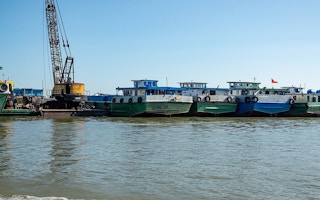The Mekong Delta is one of the world’s largest. Not only do millions of people call it home, it is an agricultural powerhouse, producing roughly half of Vietnam’s total rice harvest and nearly three-quarters of its fruit, aquaculture, and fisheries products.
But the delta — and the millions who rely on it — is under threat, from increasing saltwater levels and drought.
The culprits are well known: upstream dams, land subsidence and climate change-induced sea-level rise.
But there is another significant yet less acknowledged contributor: riverbed sand mining.
This practice not only alters the river’s characteristics but exacerbates saltwater (or salinity) intrusion, especially during drought years.
Salinity intrusion occurs when seawater penetrates inland, primarily during the dry season (January to May) when river flow is reduced.
This phenomenon is worsened by several converging factors.
Land subsidence, caused by excessive groundwater extraction, leads to the sinking of land, effectively contributing to relative sea-level rise and increasing vulnerability to saltwater intrusion.
Meanwhile, climate change-induced sea-level rise directly pushes salty water further inland.
The delta’s sand mining industry caters to the region’s construction needs which has expanded in due to rapid urbanisation. Numerous sand mining barges dot the Mekong mid-river and along its banks.
Riverbed sand mining significantly intensifies saltwater intrusion and drought in two ways.
First, sand mining deepens the riverbed, lowering the river’s base level and enhancing tidal influence, which allows seawater to intrude further inland.
Second, upstream dams trap sediment, and sand mining further depletes sediment supply downstream.
This lack of sediment weakens the river’s natural barriers against salt water, such as stabilising mangroves and the building up of crucial land. River deltas are formed by continual deposits of sediment over time.
Sediment is crucial for maintaining these natural defences. Without it, the river loses its ability to counteract the force of incoming tides and seawater.
The droughts of 2016 and 2020 were among the worst in recent history, with saltwater intrusion reaching unprecedented levels. The 2020 drought was particularly severe, occurring earlier in the season and penetrating deeper inland.
These conditions resulted in significant agricultural damage, freshwater shortages and severe impacts on the livelihoods of millions.
The increased activity of riverbed sand mining during this period exacerbated the situation.
Saltwater intrusion worsens drought conditions. It damages crops by limiting the availability of freshwater for irrigation and drinking.
There are several sustainable practices which can mitigate the impact of sand mining and saltwater intrusion.
How satellites can help
Strict enforcement of sand mining regulations, coupled with multi-scale monitoring systems, can reduce riverbed erosion and protect the river. One example is sand mining activities being monitored using satellite images across the delta in near-real time.
Measures to restore sediment flow, such as sediment bypass systems at dams, can help rebuild natural barriers against salinity intrusion. Cooperative water management agreements among Mekong River Basin countries can ensure equitable water distribution and sustainable dam operations.
Promoting salt-tolerant crops and integrated farming systems, such as mangrove rice-shrimp farming, can help communities adapt to and proactively manage changing salinity levels.
Although sand mining is often overlooked in discussions of drought drivers, its impact on saltwater intrusion and the river in the Mekong Delta is profound.
Addressing this issue through sustainable management practices is crucial for mitigating drought conditions and ensuring the resilience of the region’s agricultural systems.
By understanding and managing the complex interactions between human activities and natural processes, we can better protect the Mekong Delta and its inhabitants from the escalating threat of drought.
Edward Park is an assistant professor at Nanyang Technological University in Singapore, where he leads the Tropical Rivers Group investigating how rivers respond to natural disasters and human activities for sustainable basin management.
Dung Duc Tran is a senior research fellow at Nanyang Technological University in Singapore and Vietnam National University Ho Chi Minh City, with his background encompassing socio-hydrology and integrated water resources management for sustainable deltas.
Originally published under Creative Commons by 360info™.










